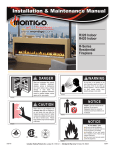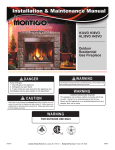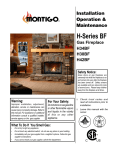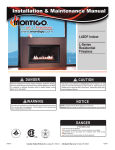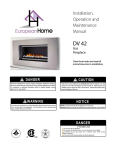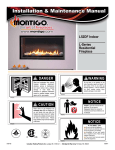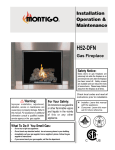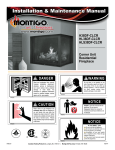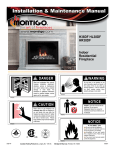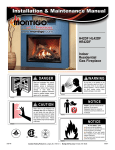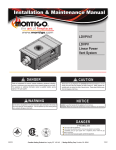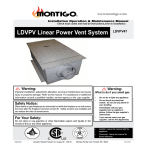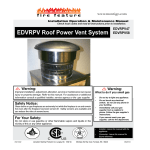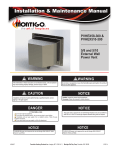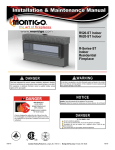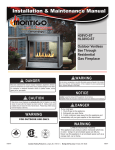Download Montigo H36PVN Owner`s manual
Transcript
H36PV Manual Installation & Maintenance Manual H36PVN Power Vent Flush Face Fireplace H36PVN Shown H36PVN Shown DANGER Read and understand this manual. Improper installation, adjustment, alteration, service or maintenance can cause serious injury, property damage or even death. For assistance or additional information consult a qualified installer, service agency or the gas supplier. WARNING Do not store or use gasoline or any other flammable vapors and liquids in the vicinity of this or any other gas burning appliance. A fire or explosion my occur causing serious injury, property damage or even death. XW2006 XW2002 NOTICE CAUTION Glass doors on gas fireplaces are extremely hot while the fireplace is on and remain hot even after the fireplace has been turned off. Safety screens are available and can reduce the risks of severe burns. Please keep children away from the fireplace at all times. Installer: Leave this manual with the appliance. Do not remove. Consumer: Retain this manual for maintenance and future reference. Do not Discard. XW2012 XW2004 NOTICE Blank IF YOU SMELL GAS Do not try to light any appliance. Do not touch any electrical switch; do not use any phone in your building. Immediately call your gas supplier from a neighbor's phone. Follow the gas supplier's instructions. If you cannot reach your gas supplier, call the fire department. Blank Flammable materials Toxic Corrosive Danger overhead crane Flammable materials Explosion risk Toxic Corrosive Danger overhead crane Fork lift trucks High voltage General Warning Laser Radiation Explosion risk Biohazard Oxidising Hot surface Danger of entrapment Fork lift trucks Danger of death High voltage Laser Radiation Biohazard Oxidising Hot surface Danger of entrapment Danger of death Slippery floor Watch your step Glass hazard Danger of suffocation Blank General Warning Irritant Flammable materials Irritant ® Watch your step Cutting High temperatures Electricity Danger for cutter Entrapment hazard Battery hazard Rotating parts Biohazard Oxidising Hot surface Danger of entrapment Danger of death Watch for falling objects Electricity Danger for cutter Strong magnetic field Optical radiation Non ionizing radiation Blank Gas bottles US High temperatures Danger overhead crane Toxic Slippery floor Watch for falling objects Laser Radiation Low temperature C Cutting Corrosive Explosion risk Gas bottles General Warning Fork lift trucks High voltage Glass hazard Danger of suffocation Entrapment hazard Battery hazard Radiation Hazardous to the Environment Danger of harming your hands Glass hazard Danger of suffocation Fork lift trucks Hazardous to the Environment High voltage Danger of harming your hands Irritant Slippery floor Watch your step Cutting High temperatures Flammable materials Low temperature Explosion risk Strong magnetic field Toxic Optical radiation Corrosive Non ionizing radiation Danger overhead crane Radiation Electricity Danger for cutter Entrapment hazard Battery hazard Gas bottles Watch for falling objects Rotating parts Rotating parts General Warning Laser Radiation Biohazard Oxidising Hot surface Danger of entrapment Low temperature Strong magnetic field Optical radiation Non ionizing radiation Radiation Hazardous to the Environment Danger of harming your hands Irritant Slippery floor Watch your step Cutting High temperatures Glass hazard Danger of suffocation Danger of death XW2014 XG0694 Canadian Heating Products Inc. Langley, BC V4W 4A1 | Montigo Del Ray Corp. Ferndale, WA 98248 030711 H36PVN Power Vent Indoor Gas Fireplace NOTICE You must read and understand this manual prior to installation, operation or troubleshooting this appliance. Please retain this owner’s manual for furure reference and maintenance. XW2010 Table of Contents Safety Alert Key. . . . . . . . . . . . . . . . . . . . . . . . . . . . . . . . Introduction . . . . . . . . . . . . . . . . . . . . . . . . . . . . . . . . . . . . 3 Installation. . . . . . . . . . . . . . . . . . . . . . . . . . . . . . . . . . . . . . 4 3 Model . . . . . . . . . . . . . . . . . . . . . . . . . . . . . . . . . . . . . . . . . . . 3 Section A: Before You Begin. . . . . . . . . . . . . . . . . . . . . . . . 4 Important Message. . . . . . . . . . . . . . . . . . . . . . . . . . . . . . . 4 Before you start. . . . . . . . . . . . . . . . . . . . . . . . . . . . . . . . . . . 4 Pre-Installation Checklist. . . . . . . . . . . . . . . . . . . . . . . . . . . 4 Understanding Basic Operation . . . . . . . . . . . . . . . . . . . . . 4 Installation Checklist. . . . . . . . . . . . . . . . . . . . . . . . . . . . . . 4 Section 1: Installation Overview and Product Dimensions . . . . . 5 The H36 PV Fireplace. . . . . . . . . . . . . . . . . . . . . . . . . . . . . 5 Fireplace dimensions. . . . . . . . . . . . . . . . . . . . . . . . . . . . 5 Clearances. . . . . . . . . . . . . . . . . . . . . . . . . . . . . . . . . . . . 5 Section 2: Framing the Fireplace . . . . . . . . . . . . . . . . . . . . 6 Rough frame-in Dimensions. . . . . . . . . . . . . . . . . . . . . . . . 6 Fireplace Installation. . . . . . . . . . . . . . . . . . . . . . . . . . . . . . 6 Section 3: Finishing . . . . . . . . . . . . . . . . . . . . . . . . . . . . . . . 7 Installing Non-combustible materials . . . . . . . . . . . . . . . . . Installing Combustible Materials. . . . . . . . . . . . . . . . . . . . . Combustible mantles and facings. . . . . . . . . . . . . . . . . . . . Fireplace facing. . . . . . . . . . . . . . . . . . . . . . . . . . . . . . . . . . Mantles and surrounds. . . . . . . . . . . . . . . . . . . . . . . . . . . . 7 7 8 8 8 Section 4: Installing the Power Vent. . . . . . . . . . . . . . . . . . 9 Installing the roof mounted power vent. . . . . . . . . . . . . . . . 9 Venting Layout. . . . . . . . . . . . . . . . . . . . . . . . . . . . . . . . . . . Typical Vertical Vent. . . . . . . . . . . . . . . . . . . . . . . . . . . . . Multi-Elbow Vertical Vent. . . . . . . . . . . . . . . . . . . . . . . . . Downward Vertical Vent. . . . . . . . . . . . . . . . . . . . . . . . . . 9 9 9 9 Venting Components. . . . . . . . . . . . . . . . . . . . . . . . . . . . . Installation of the External roof mounted power vent.. . . . . . Installing the external roof mounted power vent module. . . . . . Installing a Wall Mounted Vertical Exterior Power Vent . . . . 10. 11 12 13 Venting Layout. . . . . . . . . . . . . . . . . . . . . . . . . . . . . . . . . . Multi-Elbow Installations . . . . . . . . . . . . . . . . . . . . . . . . Downward Vertical Venting. . . . . . . . . . . . . . . . . . . . . . Venting Components. . . . . . . . . . . . . . . . . . . . . . . . . . . Installation of the external wall mounted power vent . . . . . . . Installing the external wall mounted power vent module. . . . Installing In-Line Linear Power Vent. . . . . . . . . . . . . . . 13 13 13 14 15 16 17 Venting Layout. . . . . . . . . . . . . . . . . . . . . . . . . . . . . . . . . . 17 Typical Vertical Vent. . . . . . . . . . . . . . . . . . . . . . . . . . . . 17 Page 2 Multi-Elbow Vertical Vent. . . . . . . . . . . . . . . . . . . . . . . . 17 Downward Vertical Vent. . . . . . . . . . . . . . . . . . . . . . . . . 17 Venting Components. . . . . . . . . . . . . . . . . . . . . . . . . . . . . 18 Section 5: Wiring. . . . . . . . . . . . . . . . . . . . . . . . . . . . . . . . . 19 Installation Of Electrical Supply. . . . . . . . . . . . . . . . . . . . . Installing The Remote Switch. . . . . . . . . . . . . . . . . . . . . . HSI Wiring Schematic. . . . . . . . . . . . . . . . . . . . . . . . . . . . Conduit & Wiring clearances . . . . . . . . . . . . . . . . . . . . . . IPI Wiring Schematic. . . . . . . . . . . . . . . . . . . . . . . . . . . . . 20 21 22 23 23 Section 6: Installing the Gas Line . . . . . . . . . . . . . . . . . . 24 Fuel Consumption. . . . . . . . . . . . . . . . . . . . . . . . . . . . . . . 24 Pressure requirements:. . . . . . . . . . . . . . . . . . . . . . . . . . . 24 Gas Connection. . . . . . . . . . . . . . . . . . . . . . . . . . . . . . . . . 24 Section 7:Removing & Installing the Door . . . . . . . . . . . 25 Removing the doors:. . . . . . . . . . . . . . . . . . . . . . . . . . . . . 25 Installing the Door:. . . . . . . . . . . . . . . . . . . . . . . . . . . . . . . 25 Section 8: Installing the Logset . . . . . . . . . . . . . . . . . . 26-27 Operation. . . . . . . . . . . . . . . . . . . . . . . . . . . . . . . . . . . . . . 28 Section 9: Start-up Sequence . . . . . . . . . . . . . . . . . . . . . . 28 Honeywell Intermittent Pilot. . . . . . . . . . . . . . . . . . . . . . . . 28 For Your Safety - READ BEFORE LIGHTING . . . . . . . . . 29 Lighting Instructions. . . . . . . . . . . . . . . . . . . . . . . . . . . . . . 29 Maintenance. . . . . . . . . . . . . . . . . . . . . . . . . . . . . . . . . . . 30 Section 10: Cleaning and Maintenance . . . . . . . . . . . . . . 30 Removing the log grate. . . . . . . . . . . . . . . . . . . . . . . . . . . Removing the Brick lining / Refractory . . . . . . . . . . . . . . . Removing the standoffs. . . . . . . . . . . . . . . . . . . . . . . . . . . Removing the firebox access Panel. . . . . . . . . . . . . . . . . 30 30 31 32 General . . . . . . . . . . . . . . . . . . . . . . . . . . . . . . . . . . . . . . . Cleaning. . . . . . . . . . . . . . . . . . . . . . . . . . . . . . . . . . . . . . . Troubleshooting. . . . . . . . . . . . . . . . . . . . . . . . . . . . . . . . . Replacement Parts . . . . . . . . . . . . . . . . . . . . . . . . . . . . . . 32 32 33 33 Appendix A . . . . . . . . . . . . . . . . . . . . . . . . . . . . . . . . . . . 34 Power Vent Locations. . . . . . . . . . . . . . . . . . . . . . . . . . . . . 34 Vertical Power Vent Detail. . . . . . . . . . . . . . . . . . . . . . . . . 35 Horizontal Power Vent Detail. . . . . . . . . . . . . . . . . . . . . . . 35 Appendix B. . . . . . . . . . . . . . . . . . . . . . . . . . . . . . . . . . . . 36 Warranty . . . . . . . . . . . . . . . . . . . . . . . . . . . . . . . . . . . . . . . . 36 Appendix C. . . . . . . . . . . . . . . . . . . . . . . . . . . . . . . . . . . . 37 State of Massachusetts. . . . . . . . . . . . . . . . . . . . . . . . . . . . . 37 XG0649 - 031511 H36PVN Power Vent Indoor Gas Fireplace Safety Alert Key DANGER WARNING Indicates a hazardous situation which, if not avoided, WILL result in death or serious injury or property damage. Indicates a hazardous situation which, if not avoided, COULD result in death or serious injury or property damage. CAUTION NOTICE Indicates a hazardous situation which, if not avoided, WILL result in minor or moderate injury. Address practices that are important, but not related to personal injury Introduction Warranty and Installation Information: (See Appendix B) INTRODUCTION Congratulations on your purchase of a Montigo Fireplace. With over 30 years of experience, Montigo is committed to providing you with a gas fireplace that is not only a beautiful addition to your space, but that is also designed and manufactured to the highest safety, reliability and engineering standards. We strongly encourage you to read and carefully follow the instructions laid out in this Installation, Operation and Maintenance Manual and retain it for your future reference. Pay special attention to all cautions, warnings, and notices throughout this manual intended to ensure your safety. The Montigo warranty will be voided by, and Montigo disclaims any responsibility for, the following actions: ►Modification of the fireplace and/or components including Direct-Vent assembly or glass doors. ►Use of any component part not manufactured or approved by Montigo in combination with this Montigo fireplace system. ►Installation other than as instructed in this manual. Consult your local Gas Inspection Branch on installation requirements for factory-built gas fireplaces. Installation & repairs should be done by a qualified contractor. Blank This manual covers installation, operation and maintenance. Lighting, operation and care of this fireplace can be easily performed by the homeowner. All installation and service work should be performed by a qualified or licensed installer, plumber or gas fitter as certified by the state, province, region or governing body where the fireplace is being installed. Flammable materials General Warning Explosion risk Toxic XG0649 - 031511 Natural Gas Propane 55,000 --- Fork lift trucks High v Hot surface Danger of entrapment Danger o warning Laser Radiation Biohazard Oxidising Irritant Slippery floor Watch your step Cutting High temperatures Glass hazard Gas bottles Watch for falling objects Electricity Danger for cutter Entrapment hazard Battery hazard Low temperature Strong magnetic field Optical radiation Non ionizing radiation Radiation Hazardous to the Environment Fireplace BTU/H Input Model# Danger overhead crane Hot glass will cause burns. Do not touch glass until unit is cooled. Never allow children to touch glass. This installation, operation and maintenance manual is applicable to the models described below. Refer to your rating plate to verify included options. H36PVN Corrosive Venting Type Burner Type Ignition Type Top Power Vent Traditional IPI Electronic Ignition Page 3 Danger of s Rotatin Danger of your h H36PVN Power Vent Indoor Gas Fireplace Installation Section A: Before You Begin Section: Important Message Pre-Installation Checklist Save these Instructions The H36PV Power Vent fireplaces must be installed in accordance with these Instructions. Carefully read all the Instructions in this manual first. Consult the Local Gas Branch to determine the need for a permit prior to starting the installation. It is the responsibility of the installer to ensure this fireplace is installed in compliance with the manufacturers instructions and all applicable codes. ■ Determine the desired install location of your fireplace. ■See Section 1, Dimensions on Page 5, and refer to the Framing Section 2 for details. ■Select your type and location of your Power Vent run: Roof Mounted (EDVRSPV58) or Wall Mounted (EDVWSPV58). BEFORE YOU START: ■Your termination location should be selected to provide the shortest possible vent run. ■Lay out the Vent run; calculating the required elbows and straight runs of 5"/8" flex or rigid pipe. ■Refer to the Section 4 on Page 10, "Installing the Power Vent" for details. ■Montigo supplies 20' of low voltage wire, which can be spliced to any length. This wire CANNOT run in conduit with any other wire. ■Refer to Section 5 on Page 18, for Wiring Details. ■The gas connection is located on the bottom side of the fireplace. ■Refer to local codes and guidelines for installation requirements. ■Installation and repairs should be done by a qualified contractor and must conform to: NOTICE Installation and repairs should be done by an authorized gas fireplace service technician. The appliance should be inspected before use and at least annually by a professional. More frequesnt cleaning may be required due to exessive lint from carpeting, bedding material, ect. It is imperative that control compartments, burners and circulating air passageways of the fireplace are kept clean. XW2016 CAUTION Due to high operating temperatures, this appliance should be located out of traffic & away from furniture and draperies. Children and adults should be alerted to the hazards of the high surface temperature, which could cause burns or clothing ignition. Young children should be carefully supervised when they are in the same room as the appliance. Clothing or other flammable materials should not be placed on or near the appliance. Blank Flammable materials Explosion risk Toxic Corrosive Danger overhead crane Fork lift trucks High voltage General Warning Laser Radiation Biohazard Oxidising Hot surface Danger of entrapment Danger of death Irritant Slippery floor Watch your step Cutting High temperatures Glass hazard Danger of suffocation Flammable materials Explosion risk Toxic Corrosive Danger overhead crane Fork lift trucks High voltage Electricity Blank Danger for cutter Entrapment hazard Battery hazard General Warning Laser Radiation Biohazard Oxidising Hot surface Danger of entrapment Danger of death Low temperature Gas bottles Strong magnetic field Watch for falling objects Optical radiation Non ionizing radiation Radiation Hazardous to the Environment Danger of harming your hands Rotating parts Corrosive Danger overhead crane Blank Flammable materials XW2018 Explosion risk Toxic Fork lift trucks High voltage Irritant Slippery floor Watch your step High temperatures Glass hazard Danger of suffocation General Warning Laser Radiation Biohazard Oxidising Hot surface Danger of entrapment Danger of death Gas bottles Watch for falling objects Electricity Danger for cutter Entrapment hazard Battery hazard Rotating parts Cutting Irritant Slippery floor Watch your step High temperatures Glass hazard Danger of suffocation Low temperature Strong magnetic field Optical radiation Non ionizing radiation Radiation Hazardous to the Environment Danger of harming your hands Gas bottles Watch for Electricity Danger for cutter Cutting Entrapment hazard Battery hazard Rotating parts XW2020-When-Installed_[EN].pdf 1 1/24/2011 12:48:53 PM • Installations in Canada must conform to the current CAN/CGA B-149.1 and .2 Gas Installation Code and local regulations. • Installations in the USA must conform to local codes, or in the absence of local codes to the National Fuel Gas Code, ANSI Z223.1-1988. • See Appendix C for installation within the State of Massachusetts. This fireplace must comply with NFPA-54 Chapter 10. ■ Refer to Section 6 Page 21, "Installing the Gas Line" for Details. Understanding the Basic Operation Residential H36PV fireplace DANGER When this appliance is installed directly on any combustible material other than wood flooring, it must be installed on a metal or wood panel extending the full width and depth of the appliance or a fire will occur causing serious injury, property damage or even death. To operate the fireplace, Montigo has supplied and installed twenty feet of low voltage wire to this electrical control panel. Connect the two wire harness to a standard single pole ON/ Off switch located at a location of your choice. You may also extent these wires to any length, as long as you select a wire of equal quality. XW2020 Page 4 XG0649 - 031511 H36PVN Power Vent Indoor Gas Fireplace Installation Section 1: Installation Overview and Product Dimensions Please review the Pre-Installation Checklist on Page 4 for general information on preparing for a successful installation of your fireplace. Clearances To ensure the H-Series H36PVN Fireplaces operate safely, all models must maintain the following clearances. The H-Series H36PVN & fireplace The H36PVN fireplaces may be installed in any location that maintains proper clearances to air conditioning ducts, electrical wiring and plumbing. Safety, as well as efficiency of operation, must be considered when selecting the fireplace location. Try to select a location that does not interfere with room traffic, 32” 1” has adequate ventilation, and offers an accessible pathway for Power Vent installation. Clearances to Combustibles The fireplace dimensions are shown below: 32” 8 3/4” 1” CL 8” 8 3/4” 5” CL Top 23” View Model# Top Sides Back H36PVN 8" 0" 1" Floor Floor (under) (front)* 0" 0" 8” *Note: Finishing hardwood, laminate flooring, or tile may be placed directly in front of fireplace, however Montigo waives responsibility for 23” discoloration of flooring materials. Ability to withstand heat should be 5” discussed with the flooring manufacturer. If carpet is to laid there must be a 12" clearance or hearth between the front of the fireplace and the start of the carpet. Top View 46” 2” 23” 2” 5 ¾” 46” Nailing Flange 2” 23” 9” 2” 5 ¾” Access Panel 41 ¼” 4” 9” Nailing Flange ¾” 10” 41 ¼” Front View Side View Flexible Incoming Gas Connection Left de View Blk Wht 31 ½” 38 ½” Flexible Incoming Gas Connection ¾” Left Power Vent Nailing Wall Switch Communication Flange LVT Connection Harness Port Blk Nailing Wall Switch Flange LVT Connection 38 ½” Front View Power Vent Communication Harness Port 31 ½” Wht Access Panel Main Incoming A/C Power Connection Right Side View Access Panel Main Incoming A/C Power Connection Right WARNING View The H36PVN Side & H36PVL are power vented fireplace systems. Under no circumstances can these model(s) be installed without a power vent module. For regular Horizontal vent installation use 5"/8" model EDVWSPV58 with the rough-in kit, EDVWSPV58F for the For regular Vertical vent installation use 5"/8" model EDVRSPV58 with the rough-in kit, EPVF58 for the H36PVN & H36PVL. XW2022 Figure 1. Fireplace dimensions. XG0649 - 031511 Page 5 H36PVN Power Vent Indoor Gas Fireplace Installation Section 2: Framing Step 1. To frame in the unit first frame a rough-in enclosure with combustible framing materials, using typical framing practices. The rough-in frame opening for the assembled fireplace is 46" wide, x 50" high x 24" deep. See Figure 2. NOTE: When constructing the framed opening, please ensure that your combustible 2 x 4 header is at 50" minimum and that there is access to install the gas line when the unit is installed. See Figures 1 and 2a. 46” 50” (minimum) 24” Figure 2. Fireplace installation (combustible frame dimensions) Step 2. Place the Fireplace in the enclosure and install the Vent pipe, and Power Vent module. Next, Connect the Gas line and provide a gas service shut-off valve; according to local gas codes, then secure in place with 1/4" wood screws. Install supplied Non-combustible header at 45½" from floor. Non-combustible Header (supplied by montigo), install to allow 15½” of Non-combustible cement board to fasten above the glass of the unit and Non-combustible header. Flexible incoming gas connection Secure nailing flange to 2 x 4’s using ¼" wood screws. Figure 2a. Fireplace installation, (Inlet Gas & Power Vent) . Page 6 XG0649 - 031511 H36PVN Power Vent Indoor Gas Fireplace Installation Section 3: Finishing Step 1. As shown in Figure 3; Use Non combustible Cement board, supplied by Montigo, screw to Non-combustible Header and 2 x 4's at sides of unit (see figure 2a on page 6) using sheet metal screws. Non-combustible Cement Board (supplied by montigo). Fasten above the glass of the unit to Non-combustible header and 2 x 4’s at side of unit. Figure 3. Non-combustible Cement Board the Fireplace, (supplied by Montigo). Step 2. As shown in figure 3a; Cut standard Drywall / Wall board to complete the installation of fireplace surround. Combustible Drywall / Wall Board or equivelant. Fasten above the glass of the unit to Non-combustible header and 2 x 4’s at side of unit. Figure 3a. XG0649 - 031511 Page 7 H36PVN Power Vent Indoor Gas Fireplace Vertical Run Installation 16” 15” 14” 13” 12” 11” 10” 9” 8” 7” 6” 5” 4” 3” 2” 1” To Ceiling Drywall/ Combustible Construction Combustible Construction allowed in shaded area First Combustible Header @ 50" from floor or 8” from top of unit Non-combustible Header (supplied by Montigo @ 6½”) Non-Combustible Cement Board (supplied by Montigo) 12” 11” 10” 9” 8” 7” 6” 5” 4” 3” 2” 1” Horizontal Run Non-Combustible Cement Board (supplied by Montigo) Glass Figure 3b. Combustible mantle and facings. (Not to scale) Fireplace Facing When selecting the finish material for your fireplace, it is important to remember the following: If the surround of the fireplace is to be painted to match the room decor, heat-resistant paint must be provided . Also, decorative facing must not extend past the fireplace opening at all, because it will interfere with the access to retainers for removal of glass door and access to the lower compartment. Mantels & Surrounds National Canadian Gas Association mantel test requirements are for fire hazard prevention to combustible materials. Please be aware; temperatures over the mantel will rise above normal room temperature and walls above fireplace may be hot to touch. CAUTION CAUTION We recommend careful consideration be given to the effects of elevated mantel temperatures which may be in excess of product design, for example: candles, plastic or pictures. This can cause melting, deformation, discoloration or premature failure of T.V. radio, and other electronic components. XW2034 Page 8 When covering the upper metal portion of the fireplace, (as shown, Fig.16) with a non-combustible material, Please Note: The decorative facing materials may be subject to temperatures in excess of 250° F. This should be considered when selecting facing materials. XW2036 XG0649 - 031511 H36PVN Power Vent Indoor Gas Fireplace Installation Section 4: Installing the Power Vent Multi-Elbow Installations Montigo supplies a variety of power venting options The location of the power vent should be selected and laid out to provide the shortest possible run to an external wall or through the roof In the event that the external power vent is not aesthetically acceptable or otherwise infeasible, an in-line power vent can be used with this and is included on page 17 of this instruction manual (contact Montigo for Details) Multi-elbow installations are possible up to a maximum of six at 90° elbows V3 Installing a Roof Mounted Vertical Exterior Power Vent (EDVRSPV58) Elbow 4 This section applies to installations where the shortest possible vent run is through the roof Refer to Appendix A - Power Vent locations, to ensure the planned Power vent location is acceptable Once the vent location has been established, please refer to the appropriate section below for installation details Venting Layout Elbow 5 H2 V2 Elbow 2 Elbow 3 Selection of components and details of venting lay out should adhere to the following guidelines: H1 V1 ■ Ensure there is a minimum run of 2’ of straight pipe before the power vent Elbow 1 ■ Ensure the maximum vent run does not exceed 80’ ■ Ensure the number of 90° elbows does not exceed 6 ■ Ensure the number of 45° elbows does not exceed 12 Straight Venting Layout Multi Elbow - Venting Installation V1 + H1 + V2 + H2 + V3 (Maximum Length) Max. # Elbows 80 Feet 6 Figure 4a. Multi-elbow Venting Installations. Downward Vertical Venting Venting Installation V (Maximum Length) Max. # Elbows V 100 Feet Note: The downward vent run must not exceed 6' of vent run 0 Elbow 3 Elbow 2 Figure 4 Typical straight Venting Installations. H1 V1 V3 D = 6’ foot MAX Elbow 1 WARNING: MUST on the door gasket and/or explosion ports will result in products of combustion leaking into the living space and may result in carbon monoxide poisoning. Elbow 4 H2 Elbow Multi Elbow - Venting Installation V1 + H1 + V2 + H2 + V3 (Maximum Length) Max. # Elbows 40 Feet 6 Figure 4b. Downward Venting Installations. XG0649 - 031511 Page 9 H36PVN Power Vent Indoor Gas Fireplace Installation Venting Components The following venting components and associated Montigo part numbers are available for the EDVRSPV58: A - Termination EDVRSPV58 B - Rough-in Frame EDVRSPV58F C - Flex Sections PLF-1 (12" Section) PLF-2 (24" Section) PFL-3 (36" Section) PFL 4 (48" Section) D - Rigid Sections E - Elbows F - Power Cord Harnesses Installation of the EDVRSPV58 External roof mounted power vent module. Refer to Appendix A - Power Vent locations, to ensure the planned Vertical Power vent location is acceptable. The EDVRSPV58 Power Vent dimensions: Ø14” 19 1/4” PEXT-1 (12" m/f Section) PXT-20 (20" Section) PEXT-2 (24" m/f Section) PEXT-3 (36" m/f Section) PEXT-4 (48" m/f Section) 2” PEL-90MM (m/m 90º Elbow PEL-90FF (f/f 90º Elbow PEL-90FM (f/m 90º Elbow) PEL-45FM (f/m 90º Elbow) EPVH10-10 foot power cord & harness EPVH20-20 foot power cord & harness EPVH30-30 foot power cord & harness EPVH40-40 foot power cord & harness EPVH50-50 foot power cord & harness EPVH60-60 foot power cord & harness EPVH70-70 foot power cord & harness EPVH80-80 foot power cord & harness EPVH70-70 foot power cord & harness EPVH70-70 foot power cord & harness EPVH80-80 foot power cord & harness EPVH90-90 foot power cord & harness EPVH100-100 foot power cord & harness 8 1/2” Ø 1/2” Front View 18” 18” Top View The EDVRSPV58F Rough-in Frame dimensions: Connection and installation of the vent components should adhere to the following guidelines: 6” Connect all vent sections using a minimum of three sheet metal screws on the outer pipe flue. Ensure the pipe ends male to female slide in a minimum of 1 1/2“ of overlap. Ensure all runs are supported with a minimum of 3 supports per 10’ of venting. Ø 8” When hanging/ supporting venting, ensure that 1” clearance is maintained on all sides to any combustible material. Front View Ensure when cutting sections of rigid pipe to maintain integrity of internal supports. 18” Place the springs, supplied with the pipe kit, between the outer and inner pipes to keep the pipes separate and avoid any possible hot spots. Montigo recommends the use of a flex section for the final pipe connected directly to the fireplace offering greater flexibility of installation and absorption of movement. All exterior joints in venting should be sealed with high heat silicone 706 High Temp. 14” 18” Top View Page 10 XG0649 - 031511 H36PVN Power Vent Indoor Gas Fireplace Installation Installing the external roof mounted power vent module Step 1. Construct a Vertical Chase for the termination opening to meet the following requirements: Step 3. Install the Power Vent Rough-in Kit. Pull wire harness through the supplied hole in the bottom corner of the rough-in box, and snap into the slot provided, (See figure 5b inset). Power Vent Rough-in Kit ■ Opening Size must be: 14 1/2" x 14 1/2" x 18" Min. height. 14½" 14½" Electrical Harness Connerctor Location 18" Electrical Harness Figure 5. Construction, Rough-in framing. Figure 5b. Installation of Rough-in Kit Step 2. Install the Vent pipe female end up, and 2" to 3" MAX. from the top of the Constructed Chase. Also, at this point install the Electrical harness, (EPVH-(10-100) that will communicate with the Power Vent Module. 2" to 3" Max. Step 4. Install fasteners around perimeter of Rough-in Kit. (Holes supplied for ease of installation) Electrical Harness with connection Vent Pipe Install Fasteners around perimeter of Rough-in Kit Vent Chase Figure 5c. (Fasten Rough-in Kit to framing) Figure 5a. Installation, Vertical Vent pipe. (female end top end). WARNING All venting material must be sealed with high heat silicone sealant RV230. All venting material to be Montigo flex pipe, with as few joints as possible. All joints use MVA vent splice, sealed thoroughly with silicone. Montigo will not be held responsible for any water damage that may occur from not installing the equipment as specified by this document. XW2024 XG0649 - 031511 Figure 5d. (Installed Stainless steel cover) Page 11 H36PVN Power Vent Indoor Gas Fireplace Installation Step 5. Install the Power Vent, Roof-top Stainless steel cover over the Installed Rough-in Kit. (You can see the Electrical harness connector in the top right corner). Electrical Harness from Power Vent Stainless Steel Fasteners Figure 5e. Figure 5f. Step 6. Install the Power Vent Module Power / communication harness. Hold the Power Vent in close proximity of the assembled Chase, (with stainless steel cover attached) and plug in the Power Vent communication / Power Cord. (Note the direction and orientation of the plug socket). (See Figure 5e & Figure 5f) Figure 5h. (Installed Power Vent Module) Step 8. Install (3) three stainless steel fasteners around Power Vent Module @120 degrees (penetrating through the inner stainless steel vent cover) Vertical Roof Top Power Vent Install Power Vent Module with Power / Communication Harness Vertical Roof Top Power Vent Roughin Kit CAUTION ■ Vent terminations can be very hot. The termination is to be installed higher than 7 feet above a public walkway. ■ Do not obstruct, or attempt to conceal, the vent termination. These actions will affect the operation of the fireplace, and may be hazardous. ■ In heavy snow areas, take extra care to prevent snow buildup from obstructing the vent termination. XW2026 CAUTION! Vent terminations can be very hot. The termination is to be installed higher than 7 feet above a public walkw Step 7. Do not obstruct, or attempt to conceal, the vent termination. These actions will affect the operation of the fi In Module. heavy snow takeVent extra care to prevent snow buildup from obstructing the vent termination. Install the Power Vent Place areas, the Power Module Figure 5g. (Installation of Power Vent Module) over the stainless steel cover flange and vent pipe, aligning the Power Vent into final position. Ensure the Harness is placed down in the Rough-in box when placing the Power Vent Module into place. The Power Vent Module will sit flush with the stainless steel cover if installed correctly. Page 12 XG0649 - 031511 H36PVN Power Vent Indoor Gas Fireplace Installation Installing a Wall Mounted Vertical Exterior Power Vent (EDVWSPV58) This section applies to installations where the shortest possible vent run is through an exterior wall. Refer to Appendix A - Power Vent locations, to ensure the planned Power vent location is acceptable. Once the vent location has been established, please refer to the appropriate section below for installation details. Multi-Elbow Installations Multi-elbow installations are possible up to a maximum of six at 90° elbows. Elbow 6 Once the vent location has been established, please refer to the appropriate section below for installation details. Elbow 4 Elbow 5 Venting Layout Elbow 2 ■Ensure there is a minimum run of 2’ of straight pipe before the power vent. ■ Ensure the maximum vent run does not exceed 100’. ■ Ensure the number of 90° elbows does not exceed 6. ■ Ensure the number of 45° elbows does not exceed 12. H2 V2 Selection of components and details of venting lay out should adhere to the following guidelines: H3 V3 Elbow 3 H1 V1 Elbow 1 H V Multi Elbow - Venting Installation V1 + H1 + V2 + H2 + V3 = H3 (Maximum Length) Max. # Elbows 80 Feet 6 Figure 6a. Multi-elbow Venting Installations. Downward Vertical Venting Note: The downward vent run must not exceed 6' of vent run. Venting Installation V + H (Maximum Length) Max. # Elbows 80 Feet 6 H1 Figure 6. Typical Venting Installations. V D WARNING All venting material must be sealed with high heat silicone sealant RV230. All venting material to be Montigo flex pipe, with as few joints as possible. All joints use MVA vent splice, sealed thoroughly with silicone. Montigo will not be held responsible for any water damage that may occur from not installing the equipment as specified by this document. XW2024 H2 Multi Elbow - Venting Installation V1 + H1 + D + H2 (Maximum Length) Max. # Elbows 40 Feet 6 Figure 6b. Downward Venting Installations. XG0649 - 031511 Page 13 H36PVN Power Vent Indoor Gas Fireplace Installation Venting Components The following venting components and associated Montigo part numbers are available for the EDVWSPV58: A - Termination EDVRSPV58 B - Rough-in Frame EDVRSPV58F C - Flex Sections PLF-1 (12" Section) PLF-2 (24" Section) PFL-3 (36" Section) PFL 4 (48" Section) D - Rigid Sections E - Elbows F - Power Cord Harnesses PEXT-1 (12" m/f Section) PXT-20 (20" Section) PEXT-2 (24" m/f Section) PEXT-3 (36" m/f Section) PEXT-4 (48" m/f Section) Installation of the EDVWSPV58 external wall mounted power vent module. Refer to Appendix A - Power Vent locations, to ensure the planned Vertical Power vent location is acceptable. The EDVWSPV58 Power Vent dimensions: 11 1/16" 10 9/16" 11 1/16" 11 1/16" 9 3/4" 5 PEL-90MM (m/m 90º Elbow PEL-90FF (f/f 90º Elbow PEL-90FM (f/m 90º Elbow) PEL-45FM (f/m 90º Elbow) 9.0 EPVH10-10 foot power cord & harness EPVH20-20 foot power cord & harness EPVH30-30 foot power cord & harness EPVH40-40 foot power cord & harness EPVH50-50 foot power cord & harness EPVH60-60 foot power cord & harness EPVH70-70 foot power cord & harness EPVH80-80 foot power cord & harness 9.0 EPVH70-70 foot power cord & harness EPVH70-70 foot power cord & harness EPVH80-80 foot power cord & harness EPVH90-90 foot power cord & harness EPVH100-100 foot power cord & harness 10 9/16" 5 The EPVF58 Rough-in Frame dimensions: EPVF58 DIMS (2).pdf 1 3/7/2011 9:16:30 AM Connection and installation of the vent components should adhere to the following guidelines: ■Connect all vent sections using a minimum of three sheet metal screws on the outer pipe flue. ■Ensure the pipe ends male to female slide in a minimum of 1 1/2“ of overlap. ■Ensure all runs are supported with a minimum of 3 supports per 10’ of venting. ■When hanging/ supporting venting, ensure that 1” clearance is maintained on all sides to any combustible material. ■Ensure when cutting sections of rigid pipe to maintain integrity of internal supports. ■Place the springs, supplied with the pipe kit, between the outer and inner pipes to keep the pipes separate and avoid any possible hot spots. ■Montigo recommends the use of a flex section for the final pipe connected directly to the fireplace offering greater flexibility of installation and absorption of movement. 14 1/16" 14 1/4" 9 11/16" 12 5/16" 4 12 1/8" 1 1/2" 4 9/16" 8 9 11/16" ISOMETRIC VIEW ■All exterior joints in venting should be sealed with high heat silicone RV230. Page 14 XG0649 - 031511 H36PVN Power Vent Indoor Gas Fireplace Installation Installing the external wall mounted power vent module Step 1. Construct a frame for the termination opening to meet the following requirements: ■ Opening Size must be: 14 1/2" x 14 1/2". Step 4. Insert the conduit from the Power Vent Module into the rough-in frame through the two top right entry holes. Remove the nut from the supplied strain relief and place as shown, Figure 7c. Strain Relief 14 1/2” (Opening) Power Vent Conduit Strain Relief Nut 14 1/2” (Opening) Figure 7. Framing the Opening for Power Vent Figure 7c. Installation of Power Vent Conduit Step 2. Step 5. Insert the Power Vent Rough-in Box as shown in Figure 7a. Fasten the Box securely in place with Screws or nails. Apply exterior sheathing and finishing if required. Framing Securely fasten bottom Collar pan into the Rough-in frame using the existing hardware, (4-pcs). Tighten Strain Relief nut onto Strain relief. Step 6. Fasteners Pull Power Vent Connector, (from behind) half-way through supplied hole in conduit mounting frame, and snap into place, (notches in two plastic wing clips. Orientation not critical). Strain Relief & tightened nut Rough-in Frame Power Vent Conduit Conduit mounting frame Power Vent Connector Figure 7a. Orientation, Placing the Power Vent Inner Box Step 3. Next, remove the bottom collar and conduit mounting frame as shown Figure 7b. (Place removed hardware in a handy location for re-assembly). Tightened hardware, 4-pcs. Figure 7d. (Installing Conduit connector & conduit mounting frame) Step 7. Fasten Conduit mounting frame into place using existing hardware, (6-pcs). (Coil conduit in behind cover.) Figure 7b. Installation of Rough-in Kit XG0649 - 031511 Page 15 H36PVN Power Vent Indoor Gas Fireplace Installation Installed Power Vent Connector Tightened hardware, 6-pcs. CAUTION ■ Vent terminations can be very hot. The termination is to be installed higher than 7 feet above a public walkway. ■ Do not obstruct, or attempt to conceal, the vent termination. These actions will affect the operation of the fireplace, and may be hazardous. ■ In heavy snow areas, take extra care to prevent snow buildup from obstructing the vent termination. Figure 7e. (Assembled Rough-in Kit) Step 8. Install the Power Vent Power / communication harness. Hold the Power Vent in close proximity of the assembled Rough-in Kit, and plug in the Power Vent communication / Power Cord. (Note the XW2026 CAUTION! direction and orientation of the pins inside the Power Vent connector, 7f). Vent terminations can be very hot. The termination is to be installed higher than 7 feet above a public walkw snap together). (Figure Do not obstruct, or attempt to conceal, the vent termination. These actions will affect the operation of the fire In heavy snow areas, take extra care to prevent snow buildup from obstructing the vent termination. Communication Harness. TOP of Power Vent, (Note Quantity of louvers). Note louver direction Figure 7f. (Installation of Power Vent communication harness) Step 9. Install the Power Vent. Place the Power Vent into the Rough-in frame, aligning the Power Vent into final position. Ensure the Harness is placed down in the Rough-in box when placing the Power Vent. (Secure the Power Vent in Place with the supplied hardware). Tightened hardware, 4-pcs. Figure 7g. (Completed Installation of Power Vent) Page 16 XG0649 - 031511 H36PVN Power Vent Indoor Gas Fireplace Installation Installing an In-Line Linear Power Vent (LDVPV58) This section applies to installations where an external roof or wall mounted power vent is not aesthetically acceptable or feasible. Example B. Horizontal mounting with horizontal termination Venting Installation Venting Layout Selection of components and details of venting lay out should adhere to the following guidelines: Ensure the maximum vent run does not exceed 60' Maximum vent run must be reduced by 10’ for 1’ of pipe running in a vertical downward direction Minimum Vent Run** Max. # Elbows 60 Feet 20 Feet 3 ** from fireplace to in-line power vent Ensure there is a minimum run of 2’ of straight pipe between the fireplace and the power vent Maximum Vent Run 90deg Elbow Horizontal Installed Linear Power Vent Termination LDVPV58 Horizontal Run Flex Pipe Ensure the number of 90º elbows does not exceed 3 (maximum allowable vent run must be reduced by 10’ for every additional 90º elbow added) Ensure the number of 45º elbows does not exceed 6 Linear Power Vent - Horizontal Termination Option Vertical Flex Pipe Snorkel Termination Option 90deg Elbow 90deg Elbow Flush Termination VLWB-8 Example A. Vertical mounting with horizontal termination Venting Installation Maximum Vent Run Minimum Vent Run** Max. # Elbows 60 Feet 2 Feet 3 Figure 7a. Horizontal Vent for the Linear Power Venter. ** from fireplace to in-line power vent Maximum allowable vent run must be reduced by ten feet (10'-0" for every additional 90° elbow added. With a snorkel Termination, reduce the total vent run by an additional twenty feet (20'-0"). Figure's 7 and 7a. 90deg Elbow Vertical Flex Pipe Option Snorkel Termination Vertical Installed Linear Power Vent LDVPV58 90deg Elbow Venting Installation Termination Horizontal Run Flex Pipe 2’-0 ” MIN Example C. Horizontal mounting with downward vent run and horizontal termination Maximum Vent Run Minimum Vent Run** Max. # Elbows 40 Feet 2 Feet 3 ** from fireplace to in-line power vent Maximum allowable vent run must be reduced by ten feet (10'-0") for every additional 90° elbow added. Also, deduct ten feet (10'-0") of vent length for every one foot (1'-0") of vent run traveling in a downward direction. Horizontal Installed Linear Power Vent 90deg Elbow Option 90deg Elbow Flush Termination VLWB-8 LDVPV58 Vertical Flex Pipe 90deg Elbow 6’-0” Max. Horizontal Run Flex Pipe Termination Figure 7. Vertical Mounting for the Linear Power Venter Figure 7b. HorizontaI Linear Power Vent with Downward vent and Horizontal Vent Run to Termination. CAUTION ■ Vent terminations can be very hot. The termination is to be installed higher than 7 feet above a public walkway. ■ Do not obstruct, or attempt to conceal, the vent termination. These actions will affect the operation of the fireplace, and may be hazardous. ■ In heavy snow areas, take extra care to prevent snow buildup from obstructing the vent termination. XW2026 CAUTION! Page 17 XG0649 - 031511 Vent terminations can be very hot. The termination is to be installed higher than 7 feet above a public walkway. Do not obstruct, or attempt to conceal, the vent termination. These actions will affect the operation of the fireplace, and may be hazard H36PVN Power Vent Indoor Gas Fireplace Installation Linear Power Vent - Vertical Termination Venting Installation Maximum Vent Run Minimum Vent Run** Max. # Elbows 80 Feet 2 Feet 3 Venting Components The following venting components and associated Montigo part numbers are available for the LDVPV58: ** from fireplace to in-line power vent Maximum allowable vent run must be reduced by ten feet (10'-0") for every additional 90° elbow added. Figure's 8 and 8a. Example A. Vertical Mounting with Vertical Termination A - Termination DVPV58 B - Power Vent LDVPV58 C - Control Module RHSIT05 D - Flex Sections PFL-1 (12" Section) PFL-2 (24" Section) PFL-3 (36" Section) PFL-4 (48" Section) E - Rigid Sections PEXT - 1 (12" m/f Section) PXT-20 (20" section) PEXT - 2 (24" m/f Section) PEXT - 3 (36" m/f Section) PEXT - 4 (48" m/f Section) F - Elbows PEL-90MM (m/m 90° Elbow) PEL-90FF (f/f 90° Elbow) PEL-90FM (f/m 90° Elbow) PEL-45FM (f/m 45° Elbow) G - Power Cord Harnesses: EPVH10 -10 foot power cord and harness EPVH20 -20 foot power cord and harness EPVH30 -30 foot power cord and harness EPVH40 -40 foot power cord and harness EPVH50 -50 foot power cord and harness EPVH60 -60 foot power cord and harness EPVH70 -70 foot power cord and harness EPVH80 -80 foot power cord and harness EPVH90 -90 foot power cord and harness EPVH100 -100 foot power cord and harness Termination 2’-0 ” MIN Vertical Flex Pipe 90deg Elbow 90deg Elbow Vertical Installed Linear PowerV ent LDVPV58 2’-0 ” MIN 90deg Elbow 90deg Elbow Figure 8. Vertical Vent for the Linear Power Venter Example B. Vertical Mounting with Vertical Termination Termination 2’-0 ” MIN 90deg Elbow 90deg Elbow Vertical Installed Linear Power Vent LDVPV58 90deg Elbow 90deg Elbow Vertical Flex Pipe Connection and installation of the vent components should adhere to the following guidelines: Connect all vent sections using a minimum of three sheet metal screws on the outer pipe flue. Ensure the pipe ends male to female slide in a minimum of 1 1/2" of overlap. Ensure all runs are supported with a minimum of 3 supports per 10’ of venting. When hanging/ supporting venting, ensure that 1” clearance is maintained on all sides to any combustible material. Ensure when cutting sections of rigid pipe to maintain integrity of internal supports. Place the springs, supplied with the pipe kit, between the outer and inner pipes to keep the pipes separate and avoid any possible hot spots. Montigo recommends the use of a flex section for the final pipe connected directly to the fireplace offering greater flexibility of installation and absorption of movement. All exterior joints in venting should be sealed with high heat silicone RV230. Figure 8a. VerticaI Linear Power Vent with Vertical Vent Run Page 18 XG0649 - 031511 Installation 13 5/16" Installation of the LDVPV58 power vent module: 1. The linear power vent can be installed to existing stud construction or directly to cement wall or roof. The LDVPV58 must maintain the clearance to combustibles as shown in Figure 9a. The required service access panel must be framed at 28" X 18". To enclose the service access panel, (at less than 2") a minimum 30% free air must be supplied at all times. 20 3/16" 2. Plug the power cord into the available slot in the linear power vent. 3. Secure all venting joints with at least three screws and ensure that the joints are properly sealed by applying high temperature silicone. 16 1/2 34 7/8 1/2 MIN Vent 18 1/8" Louvres 2 MIN Figure 9b. 5 MIN 5 5 MIN 8 LDVPV58 Power Vent framing dimensions. Recessed Termination Installation (VLWB-8) Refer to Appendix A Termination locations 11 33 Access Cover The VLWB-8 termination is designed to be installed flush with the exterior of the building. This recessed design uses 5"/8" vent and allows the installation to be clean and flush so it does not interfere or have an impact with your architectural design. 8 ISOMETRIC VIEW (NTS) 2 Top View Side View Figure 9. LDVPV58 Power Vent overall dimensions. Framing 12 9/64" Dimensions 5 MIN 28 clearance for Cover access /8" H36PVN Power Vent Indoor Gas Fireplace 1 181/2 5 MIN Figure 10. TERMINATION, VERTICAL MOUNT, 5/8", 12" X 20" BOX Linear Power Vent recessed Termination. DIMENSIONS ARE IN INCHES DATE NAME TOLERANCES: NOTE: 7/29/2010 LF DRAWN BY 1/32" FRACTIONAL .015" TWO PLACE DECIMAL The H36PVN requires a specific volume of atmospheric interchange CHECKED BY .005" THREE PLACE DECIMAL to operate properly and efficiently MATERIAL ALL BENDS ARE ASSUMED SIZE DWG. NO. VLWB-8 TO BE 90 UNLESS NOTED requires a MIN 80in/sq.Aair movement to function. The fireplace FINISH OTHERWISE. 304 S.S.T. SCALE NTS WEIGHT: grille OF must alsoHEATING be able to shed water, not The DRAWING IS THE SOLE PROPERTY OF CANADIAN HEATING PRODUCTS. ANY REPRODUCTION IN PART OR AS A WHOLE WITHOUT THE WRITTEN PERMISSION CANADIAN PRODUCTS IS PROHIBITED. Access Cover moisture to enter the unit. allowing any Must be left clear on both ends of Power Vent for adequate ventilation. Figure 9a. LDVPV58 Power Vent framing dimensions. XG0649 - 031511 Page 19 SHEET 1 O H36PVN Power Vent Indoor Gas Fireplace Installation Section 5: Wiring The Fireplace A/C power and Power Vent harness's must be installed before completing the installation of the H36PVN Fireplace. These connections are made from the RH-Side of the fireplace, Figure 12 through Figure 12f. Step 2. Locate all the Power vent connections & ports, Figure 12b. Power Vent, Communication port. Power vent communication conduit, A/C connection port Incoming A/C Power Connection Figure 12b. Locate Power vent connections. Figure 12. Incoming A/C Power , (connect per. Local Codes). Install the Power Vent connections as described below: Note: To access the fireplace electrical connections from the firebox follow the procedures described in figure 22 through 26. Step 1. Remove the exterior Access cover, shown Figure 12a. Power Vent, & A/C Access Cover Step 3. Remove the Power Vent communication port cover from cabinet, (as supplied) Figure 12c. (Philips head screwdriver required). Step 4. Place the cover plate on the Conduit, then tighten the strain relief nut onto the threads protruding through backside of cover plate, Figure 12e. Figure 12a. Remove Exterior Access Cover. Page 20 XG0649 - 031511 H36PVN Power Vent Indoor Gas Fireplace Installation Step 5. Route the Power Vent Comunication conduit into the cover as shown, and connect to the communication Port, Figure 12d. Installing The Remote Switch Note orientation of connector The H36PVN's Remote LVT (Low Voltage) Switch conduit is located on the RH Side of the fireplace. Note: The switch location must not exceed 30' from the fireplace. Power vent communication harness port Power vent communication port cover. Power vent communication harness. Figure 12c. Remove Exterior Access Cover. Figure 12d. connections. Locate Power vent Note orientation of conduit plug into the Port, (flat side / notches). Step 6. Re-Install the communication harness Port cover, Figure 12e. (Philips head screwdriver required). Remote Switch LVT Figure 12f. Installing the Remote LVT Switch. Step 7. Tighten Power Vent Strain relief adjustmsent screw, Figure 12e. Power vent communication port cover strain relief. Power vent communication port cover fasteners. Figure 12e. Installing Conduit Port Cover Plate. Figure 12g. Electrical Enclosure Dimensions XG0649 - 031511 Page 21 H36PVN Power Vent Indoor Gas Fireplace Installation WARNING If the information in these instructions is not followed exactly, a fire or explosion may result causing property damage, personal injury or death. XW2008 Figure 13. Wiring schematic for the H36PVN. Page 22 XG0649 - 031511 H36PVN Power Vent Indoor Gas Fireplace Installation Figure 13a. H36PVN, SIT IPI Wiring Schemmatic Conduit & Wiring clearances Connect the wiring to the linear power vent as outlined in the previous section, and connect the wiring to the fireplace as outlined in the H36PVN schematic, figure 13. Ensure that the proper clearances are maintained for the wiring and conduit. When installing the wiring it must never run above the vent run and it must be at least 1" clear of all venting. 1” Clearance Figure 13b. Conduit and Wiring Clearances. XG0649 - 031511 Page 23 H36PVN Power Vent Indoor Gas Fireplace Installation Section 6: Installing the Gas Line FUEL CONVERSION Verify that your fireplace is compatible with your available gas type. (Natural Gas or Propane shown by "N" or "L" in your model number If gas type is not compatible, contact your local Montigo representative to purchase a conversion kit. Conversion kits must be installed by a qualified service technician. Figure 14. Gas line access. (See Figure 1, L-H Side View) 10” Back of Fireplace GAS PRESSURE Optimum appliance performance requires proper input pressures. Gas line sizing requirements will be determined in ANSI Z221.3 National Fuel Gas Code in the USA and CAN/CGA B149 in Canada. Pressure requirements are: 4” Flexible Input Gasline, (Supplied) Gas line & valve: Exterior Access 3” The H36PVN is supplied one (1) one exterior access Panel (LH-side firebox). This panel is fastened directly to the exterior of the firebox with sheet metal screws. To remove the panel follow the steps below: Pressure Requirements Gas Pressure Natural Gas Propane Minimum Inlet Pressure 5.5" W.C. 11" W.C. Manifold Pressure 3.5" W.C. 10" W.C. The manifold outlet pressure is set from the factory to the appropriate pressure but should be verified. To check pressures, control valves have a provision to remove a 1/8” N.PT. plug to be fitted with a hose barb. Montigo requires a service shut off valve be located in an accessible location to isolate the gas supply. Only install gas shut-off valves approved for use by the state, province, or other governing body in which the fireplace is being installed. Exterior gas access panel hardware, 10-pcs. Figure 15a. (Inset) GAS CONNECTION See Figure 22 below for location of gas line access. Flexible gas connectors must not exceed 3 feet in length, unless allowable within local regulations. Connect incoming gas line to the 1/2"or 3/8" gas inlet port. Purge all air out of gas line. Check appliance connection, valve and valve train under normal operating pressure with a commercially available leak check solution. Figure 15. (Removing the Gas valve panel hardware). Gas In, Figure 14 Gas Valve DO NOT USE A FLAME OF ANY KIND TO TEST FOR LEAKS. Note: After gas line is connected, each appliance connection, valve and valve train must be checked while under normal operating pressure with either a liquid solution, or leak detection device, to locate any source of leak. Tighten any areas where bubbling appears or leak is detected until bubbling stops completely or leak is no longer detected. Figure 15b. (Incoming gas supply line (supplied by Montigo) and top of Gas valve). NOTICE Important Note: The flexible gas line supplied with the H36PV* may not be acceptable in the jurisdiction which this fireplace is being installed. Please check the Local Gas codes or bylaws for the State or Province prior to installation. When pressure testing the fireplace, Gas line, and input system follow the appropriate local codes or your area. DO NOT connect the fireplace to pressures in excess of 1/2lb. This will damage the gas control valve. XW2032 Page 24 XG0649 - 031511 Section 7: Installing & Removing the Door H36PVN Power Vent Indoor Gas Fireplace Installation Section 7: Installing & Removing the Door Removing the doors: The doors are removed in a few simple steps. Follow the steps below to remove the Vertical Door trim, place the Door removal tool, and then remove the door. Replace all the parts in reverse order. Step 3. Hold the Glass Removal Tools firmly, Lift the door upward, into the top door frame, Figure 17c. Then pull the bottom of the glass door downward, and tilt outward from the bottom fireplace door frame. Figure 17d. NOTE: Read ALL the instruction supplied with the tool, and follow the associated operating procedures. Step 1. Remove the two (2) Vertical Trim pieces, (LH & RH). Pulling firmly with your fingers, remove from the bottom then the top. (See Figures 17 & 17a). Other side Typical. Lift Upward into the door frame. Lift Downward & away from frame. Figure 17c. (Lift the door upward) Figure 17d. (Lift the bottom of the door outward). Step 4. Still holding the Glass Removal Tool firmly, remove the door outward, and away from the Fireplace, Figure 17e. Step 5. Place the door in a safe location while maintenance, cleaning or other operation are in progress. Figure 17. (Remove LH Trim) NOTE: Read ALL the instruction supplied with the tool, and follow the associated operating procedures. Figure 17a. (Remove RH Trim) Step 6. To replace, See Installing the Door, Below. Step 2. Remove the supplied glass lifting tool from the packaging. Place in the center of the Glass door as shown, and activate the suction feature of the tool, Figure 17b. NOTE: Read ALL the instruction supplied with the tool, and follow the associated operating procedures. Figure 17e. Installing the Door: To install the door, follow Steps 1 and 4 above, (in reverse order)..Hook the top edge of the door frame into place. Lower and rest the door frame in place and fasten the buckles. See figures 28a and 28b. NOTICE Do not use ammonia based or abrasive cleaners on the glass, they will permanently etch the surface. Use an approved gas fireplace glass cleaner such as Kel-Kem or White off. Figure 17b. Supplied Glass lifting tools. XW2000 XG0649 - 031511 Page 25 H36PVN Power Vent Indoor Gas Fireplace Installation Section 8: Installing the Log Set Installing the Logs: The H36PVN is supplied with six (6) piece ceramic fibre logs. Install as described below: Step 1. Unpack the logs and handle them very carefully. Set them aside in a safe location until required. Step 3.Position Back Log 'A' from the previously unpacked package, (Figure 18). Place the Log upright, (as shown Figure 18d) and move the Log flush against the sheet metal Back Pan. Without pressing the Log down, move it as far to the left as possible, bumping the bottom Left corner against the alignment tab, (Figure 18a & 18d). Lastly, Press the Log FIRMLY downward, onto the sharp spikes, shown in Figure 18a & 18e. Log A Figure 18. Packaged LogSet as supplied from Montigo. Log A Retaining Clip Figure 18d. Location of Log 'A'. Log A back-pan Log A Alignment Tab Move Log ‘A’ left and bump against Alignment Tab Log A Spikes Log C Rest Log D Rest Log D Spikes Log ‘A’ Spikes Log B cradle & Spike Log C Spikes Log B Rest Left end Rest Alignment Tab Log E Spike Figure 18a. Log Grate Details & identification. Step 2. L ocate the Log Back Pan Retaining clip, Figure, 18a above and remove, Figures, 18b & 18c. Place in a safe location (Philips head screwdriver required). Figure 18e. Alignment of Log 'A'. Figure 18f. Log 'A' Spikes, Figure 18a. Step 4.Once the 'Back Log 'A' is in it's final Position, hold the log in place, and reinstall the Retaining Clip (removed earlier). Press down the Clip for the sharp teeth to penetrate into the top of the Log. (Figure 18g). (Philips head screwdriver required). Figure 18b. Figure 18c. Figure 18g. Securing Log 'A'. Page 26 XG0649 - 031511 H36PVN Power Vent Indoor Gas Fireplace Installation Step 5. Position the Bottom Right Log 'B' and place Right end in the sheet metal cradle (located at the far right of the Log Grate), Figure, 18h. and Log Rest in the center of the burners, Figure, 18a. Press FIRMLY onto the spikes. Note location of hole feature in Log. Step 8. Place Front Left Log 'E', with the Knots pointing in the directions shown, Figure, 18k. Place the Darker, narrow end on top of Log 'A' as shown, (arced line). Press FIRMLY onto the sharp spike at Lower end, Figure 18a. Knot Log A Log B Log E Knot Figure 18h. Positioning of Log (B). Step 6. Position Bottom Center Log 'C', with the flat edge down. and place square end inside Log Rest, aligning the center of the Log with the Spikes, Figure, 18a. Press FIRMLY, seating the Log onto the sharp spikes, Figure 18i. Note the color variation in the Log. Figure 18k. Installation of Log 'E'. Step 9. Position Front Right Log 'F', with the Knots pointing in the directions shown, Figure, 18l. Place the Lighter, narrow end on top of Log 'E' as shown, (arced line). Align for length and location, Figure 18k. Knot Knot Log E Log F Log C Knot Figure 18i. Installation of Log 'C'. Step 7. Place Bottom Left Log 'D', with the flat edge down. and place square end inside Log Rest, aligning the center of the Log with the Spikes, Figure, 18a. Press FIRMLY, seating the Log onto the sharp spikes, Figure 18j. Note the color variation in the Log. Figure 18l. Installation of Log 'F'. Log D Figure 18j. Installation of Log 'D'. XG0649 - 031511 Figure 18m. Completed Log Set Installation. Page 27 H36PVN Power Vent Indoor Gas Fireplace Operation Section 9: Start-up Sequence WARNING If the information in these instructions is not followed exactly, a fire or explosion may result causing property damage, personal injury or death. XW2008 Startup Sequence: 1) Turn the wall switch ON 4) This may need to be done three or four times to bleed all of the air out of the gas lines within the fireplace 2) The blowers will start and within 10 seconds the glow plugs will start to glow 3) If the pilot does not light the gas valves willl turn the glow plugs off after 20 seconds 5) Turning the switch OFF and then ON again will reset this start up sequence 6) Once the pilots are burning the main burner will turn on and the fireplace will be functional for a quick start up on next use. CAUTION ■ This fireplace has been set up at the factory for a determined air volume though the venting system. ■ This fireplace will not operate unless the correct air movement is detected by our control system.. ■ Please consulted with your contact person at Montigo should you have any problems with your start up. XW2040 Page 28 XG0649 - 031511 H36PVN Power Vent Indoor Gas Fireplace Operation Proflame SIT Electronic Ignition For Your Safety - READ BEFORE LIGHTING: with American Flame Electronic Ignition WARNING If the information in these instructions is not followed exactly, a fire or explosion may result causing property damage, personal injury or death. XW2008 A.This appliance is equipped with an ignition system that lights the pilot burner automatically. Do not attempt to light the pilot by hand. B.BEFORE LIGHTING smell all around the appliance area for gas. Be sure to smell next to the floor because some gas is heavier than air and will settle on the floor. What To Do If You Smell Gas: Do not try to light any appliance. Do not touch any electrical switch; do not use any phone in your building. Immediately call your gas supplier from a neighbour's phone. Follow the gas supplier's instructions. If you cannot reach your gas supplier, call the Fire Department. C.Use only your hand to push in or turn the gas control knob. Never use tools. If the knob will not push in or turn by hand, don't try to repair it, call a qualified service technician. Force or attempt to repair may result in a fire or explosion. D.Do not use this appliance if any part has been under water. Immediately call a qualified service technician to inspect the appliance and to replace any part of the control system, and any gas control which has been under water. Lighting Instructions: 1. STOP! Read the safety information above on this label. 2. Remove the lower Horizontal access panel. 3. Turn Incoming gas valve to the ON" position. 4.Wait 5 minutes to clear out any gas. If you smell gas, STOP! Follow "B" in the safety information above on this label. If you don't smell gas, go to the next step. 5. Turn wall switch "ON". 6. If the Fireplace does not light, the System will cycle through two trials, (one minute audible clicking, thirty seconds of silence, and then another one minute of audible clicking). If the system locks out due to inadequate gas flow, refer to "Troubleshooting", Page 20. 7. After completion of the information in the Troubleshooting section, Repeat step 5. 8.If the system will not function correctly, follow the instructions "To Turn Off Gas To Appliance" and call your service technician or gas supplier. EV1 (Pilot burner) EV2 (Main burner) Pilot Adjust Screw Pilot Sensor Lockout Reset Key Diagnostic Terminal Igniter Ground EV1 (Pilot burner) EV2 (Main burner) Power Gas "In" Incoming Gas Line, Shut-off Valve Gas "Out" To fireplace Main burner Command (Wall switch) To Turn Off Gas To Appliance: 1. Turn off remote switch. 3. Turn the incoming gas control valve to "Off". 2. Remove the lower Horizontal access panel. 4. Replace the lower Horizontal access panel. XG0649 - 031511 Page 29 H36PVN Power Vent Indoor Gas Fireplace Maintenance Removing the Log Grate: Step 1 & 2. Figure 20. (Pilot mounting machine screws). The H36PVN is supplied with a log Grate that is fastened directly to the base of the Fireplace. To remove the Grate, to perform certain Maintenance functions, follow the steps described below: 5 Step 1. CLOSE GAS VALVE AT INCOMING TO FIREPLACE, (By Qualified Persons ONLY, See 'Before You Start' in the Index). 2 1 Step 3 & 4. Figure 20a. (LH Base mounting machine screw). Figure 20b. (RH Base mounting machine screw). 4 Step 2. Remove the two (2) machine screws that hold the Pilot Assembly in place, Figure 20. (Philips head screwdriver required). 3 Step 5. Figure 20c & 20d. Loosen, and Remove the Flexible Gas hose (at fitting), (turn clockwise, left to right) (3/4" Open end wrench required). 2 1 Figure 20e. (Log Grate Removal Sequence). Figure 20. (Pilot mounting machine screws). Step 3 & 4 Remove the two (2) (RH & LH) Base mounting machine screws, Figure 20a & 20b. (Philips head screwdriver required). Removing the Refractory: The H36PVN is supplied three (3) pieces of firebox refractory Lining. These panels are fastened directly to the interior sides, and back of the Fireplace firebox with brackets. To remove the brackets and panels follow the steps described below: 4 3 Figure 20b. (RH Base mounting machine screw). Figure 20a. (LH Base mounting machine screw). Step 5. Loosen, and Remove the Flexible Gas hose (at fitting), (turn clockwise, left to right) Figure 20c & 20d. (3/4" Open end wrench required). Step 1. Remove the RH-TOP machine screw that hold the Side Refractory panel in place, then the bottom, Figure 22. (Philips head screwdriver required). Step 2. Remove the RH-Refractory panel from the firebox, Figure 22. (Place the Refractory panel somewhere safe where it will not get chipped or damaged). Step 3. Follow step1 & 2 to remove the LH-Side Refractory panel, Figure 22. (Philips head screwdriver required). Bottom Brackets Back-Panel Top Brackets LH-Panel 5 RH-Panel 5 Figure 20c. (Gas fitting). Figure 20d. (Loosening Gas fitting on burner). Figure 22. (Removing Refractory panels). NOTE: Ensure all 5-steps are complete before removing Log Grate. (Failing to do so may damage the flexible gas hose, or mounting hardware of the grate). Figure 14e. Page 30 XG0649 - 031511 H36PVN Power Vent Indoor Gas Fireplace Maintenance Removing the Stand-off Panels: Removing the Access Panel: The H36PVN is supplied two (2) two Stand-off Panels (RH & LH) that hold the firebox refractory Lining in place. These panels are fastened directly to the interior sides of the firebox with sheet metal screws. To remove the panels follow the steps described below: The H36PVN is supplied one (1) one interior access Panel (RH-side) that contains the electronics and power control circuits. This panel is fastened directly to the interior of the firebox with sheet metal screws. To remove the panel follow the steps below: Step 1. Remove the RH Refractory Panel as described in Figure 22. Step 1. Remove the two (2) RH-TOP machine screw that hold the Side panels in place, then the bottom two (2) machine screws, Figure 24. (Philips head screwdriver required). 2 Step 2. Remove the RH Refractory Stand-off Panel as described in Figure 24 & 24a. Step 3. Having these two steps completed, remove the eight (8) machine screw that hold the Side panels in place, Figure 26. (Philips head screwdriver required). Top 1 Step 4. Slightly tilt panel, and pull out between the grate and firebox wall, Figure 26a. Figure 24. (Inset). 3 Power Vent Control Access Panel 4 Access Panel hardware, 7-pcs Figure 24. (Removing interior stand-off panel hardware). Step 2. Tilt the panel out from the top, and remove the panel from the firebox. Pull out of the firebox straight, toward you without hitting the Grate or panel Retaining brackets, Figure 24a. Grate Note: Place the panel somewhere safe where it will not get damaged. Side panel retaining bracket, 4-places Figure 26. (Removing the panel hardware). Figure 26a. (Removing the panel from the firebox). 12d). Grate Figure 24a. (Removing interior stand-off panels). Blk Step 3. Follow step1 & 2 to remove the LH-Side panel, Figure 24 & 24a. (Philips head screwdriver required). Wht 12f) . 12). Figure 26b. (A/C Connections, Gas module and fireplace chassis). See figure 13, Schematic). XG0649 - 031511 Figure 26c. (Remote LVT Switch connection). See figure 13, Schematic). Page 31 H36PVN Power Vent Indoor Gas Fireplace Maintenance Removing the Interior firebox Access Panel: The H36PVN is supplied one (1) one interior access Panel (LH-side firebox) that contains the Gas valve, and electronics. This panel is fastened directly to the interior of the firebox with sheet metal screws. To remove the panel follow the steps below: Step 1. Remove the LH Refractory Panel as described in Figure 22. General Have the fireplace and installation inspected yearly. The inspection must include, but is not limited to, the following: • A visual check of the entire vent system and termination. • An inspection of the explosion relief flappers and the door gasketing to ensure a proper seal. • An inspection of the burner, venturi, and primary air openings. Step 2. Remove the LH Refractory Stand-off Panel as described in Figure 24 & 24a. • An inspection of the gas valve, gas components, and pilot flame. For your convenience a 1/8" manifold pressure tap is supplied on the gas valve for a test gauge connection. Step 3. Once these two steps are complete, remove the eight (8) machine screw that hold the Side panels in place, Figure 28. (Philips head screwdriver required). • Ensure proper log placement as per this manual. Step 4. Slightly tilt panel, and pull out between the grate and firebox wall, Figure 28a. • Inspection of all optional equipment; fans, thermostats, etc. For Natural Gas this appliance requires a minimum inlet pressure of 5.5" W.C. and a manifold pressure of 3.5" W.C. For Propane Gas this appliance requires a minimum inlet pressure of 11" W.C. and a manifold pressure of 10" W.C. Always keep the fireplace area clear and free of combustible materials, as well as gasoline and other flammable vapors and liquids. Access Panel hardware, 7-pcs Do not use this appliance if any part has been under water. Immediately call a qualified service technician to inspect the appliance and to replace any part of the control system and any gas control which has been under water. Gas Valve Gas Valve, Control Access Panel Cleaning Grate Grate Figure 28. (Removing the panel Figure 28a. (Removing the panel from the firebox), incoming gas from service hardware). and Gas valve. When the fireplace is first activated, there may be some smoking and a visible film may be left on the glass. This is a normal condition, and is the result of burning of protective coatings on new metal. Glass must be cleaned periodically to remove any film (which is a normal by-product of combustion) which may be visible. Film can easily be removed by removing the door, as shown on Page 23. Handle the door carefully, and clean it with non-abrasive glass cleaners. One of the most effective products is Kel Kem. Silicone seals on inner door during initial firing will "off gas", leaving a visual deposit of a white substance on combustion chamber walls. This can easily be removed using normal household products. Use a vacuum cleaner or whisk broom to keep the control compartment, burner, and firebox free from dust and lint. Gas Valve Logs may be cleaned periodically with a vacuum to remove soot or other contaminates. Blk Wht Gas valve Valve Gas Electronics electronics Figure 28b. (Gas valve and Gas valve electronic module). See figure 13a, Schematic). Page 32 Figure 28c. (Gas valve electronic module A/C Connection). See figure 13a, Schematic). XG0649 - 031511 H36PVN Power Vent Indoor Gas Fireplace Maintenance Section: Troubleshooting: (SIT - IPI Electronic) 1. 1. Locate the lead to the battery backup, (remove) (Refer to schematic, below) 2. 2. Locate the AC/DC wall transformer, (Unplug connector) (Refer to schematic, below) If your fireplace still does not operate correctly, consult your dealer or the manufacturer. Replacement Parts XG0649 - 031511 Part Description Part Number Gas Valve - N.G. Manual Hi low RGC3044 Pilot Assembly - N.G. - Complete RPA033 Igniter Probe Assembly RGC3052 Flame sensor rod assembly RGC3053 Pilot Tubing 18" Length RPTA03 Control Module RGC3035 Wiring Harness RGC3041 DC Adapter RGC3043 Power Vent Control Box ECB007 Log Set RLGSHW42 Page 33 H36PVN Power Vent Indoor Gas Fireplace Appendix Appendix A: Power Vent Locations V Horizontal Detail Vertical Detail A = clearance to the termination frame above grade, veranda, porch, deck, or balcony [30 inches (75 cm) minimum] N = † clearance above paved sidewalk or a paved driveway located on public property [*7 feet (2.1 m) minimum] B = clearance to door, or sides and top of window, that may be opened [30 inches (75 cm) minimum for appliances. P = clearance under veranda, porch, deck, or balcony [30 inches (75 cm) minimum‡ to non-combustibles] [30 inches (75 cm) minimum‡ to combustibles] C = clearance to bottom of window that may be opened horizontally [36 inches (92 cm) minimum for appliances. Q = clearance above a roof [18 inches (46 cm) minimum] D = no clearance to permanently closed window when installed with approved glass penetration termination R = clearance to adjacent walls and neighboring buildings [30 inches (75 cm) minimum] E = clearance to permanently closed window [30 inches 75 cm recommended to prevent condensation on window] S = clearance from corner in recessed location [30 inches (75 cm) minimum] F = vertical clearance to ventilated soffit located above the termination within a horizontal distance of [30 inches 75 cm] from the centreline of the termination [30 inches (75 cm) minimum] U = minimum width for back wall of recessed location [60 inches (150 cm) minimum] G = c l e a r a n c e t o u n v e n t i l a t e d s o f f i t [ 3 0 i n c h e s (75 cm) minimum to non-combustibles] [30 inches (75 cm) minimum to combustibles] H = clearance to outside corner [30 inches (75 cm) minimum] I = clearance to inside corner [30 inches (75 cm) minimum] J = * not to be installed above a meter/regulator assembly within 40" (103 cm) horizontally from the centreline of the regulator K = clearance to service regulator vent outlet [3 feet minimum in the United States] [*6 feet (1.8 m) minimum in Canada] L = clearance to non-mechanical air supply inlet to building or the combustion air inlet to any other appliance [16 inches (41 cm) minimum for appliances ≤100 000 BTU/H (30kW)] T = maximum depth in recessed location [48 inches (122 cm) minimum] V = minimum horizontal clearance between the frames of two terminations that are level, (see applicable Detail). W = horizontal clearance between the frames of two terminations that are not level. [30 inches (75 cm) minimum] a vent shall not terminate directly above a sidewalk or paved driveway which is located between two single family dwellings and serves both dwellings only permitted if veranda, porch, deck, or balcony has an open side that is equal to or greater than the depth of the enclosed area * as specified in CGA B149 Installation Codes. Note: local Codes or Regulations may require different clearance. † ‡ M = clearance to mechanical air supply inlet [*6 feet (1.8 m) minimum] Page 34 XG0649 - 031511 H36PVN Power Vent Indoor Gas Fireplace Appendix Appendix A: Power Vent Locations EDVRSPV58 Vertical Power Vent Detail EDVWSPV58 Horizontal Power Vent Detail Wall 30”Min. “R” Wall Eaves / Overhang Wall 30”Min. “F” & “G” 30”Min. “R” Top View “R” 24” (61cm) Min. “V” 30”Min. “H” & “I” 30” (75cm) Min. “V” Front View Wall 18” 18” Min. Front View Not Acceptable Front View Side View XG0649 - 031511 Page 35 H36PVN Power Vent Indoor Gas Fireplace Appendix Appendix B: Warranty The Warranty The Companies warrants the Montigo Gas Appliance to be free from defects in materials and workmanship at the time of manufacture. On the Montigo fireplace, there is a ten-year warranty on the firebox and its components, a five-year warranty on the main burner and pilot burner, and a one-year warranty on the gas control valve, fibre logs and Power Vent Module. The Glass, plated / painted finishes, and refractory lining are exempt from the warranty. Remedy And Exclusions The coverage of this Warranty is limited to all components of the Gas Appliance manufactured by The Companies. This Warranty only covers Montigo Gas Appliances installed in the United States or Canada. If the components of the Gas Appliance covered by this Warranty are found to be defective within the time frame stated (see The Companies right of investigation outlined below). The Companies will, at its option, replace or repair defective components of the Gas Appliance manufactured by The Companies at no charge, and will also pay for reasonable labour costs incurred in replacing or repairing components. If repair or replacement is not commercially practical, The Companies will, at its option, refund the purchase price of the Montigo Gas Appliance. This Warranty covers only parts and labour as provided above. In no case shall The Companies be responsible for materials, components, or construction which are not manufactured or supplied by The Companies, or for the labour necessary to install, repair or remove such materials, components or construction. All replacement or repair components will be shipped F.O.B. the nearest The Companies factory. Qualifications To The Warranty The Gas Appliance Warranty outlined above is further subject to the following qualifications: (1) The Gas Appliance must be installed in accordance with The Companies installation instructions and local building codes. The Warranty on this Montigo Gas Appliance covers only the component parts manufactured by The Companies. The use of components manufactured by others with this Montigo Gas Appliance could create serious safety hazards, may result in the denial of certification by recognized national safety agencies, and could be in violation of local building codes. This warranty does not cover any damages occurring from the use of any components not manufactured or supplied by The Companies (2) The Montigo Gas Appliance must be subjected to normal use. The Gas Appliances are designed to burn gas only. Burning conventional fireplace fuels such as wood, coal or any other solid fuel will cause damage to the Gas Appliance, will produce excessive temperatures and will result in a fire hazard. Limitations On Liability It is expressly agreed and understood that The Companies sole obligation, and purchaser's exclusive remedy under this Warranty, under any other warranty, expressed or implied, or in contract, tort or otherwise, shall be limited to replacement, repair, or refund, as specified above. In no event shall The Companies be responsible for any incidental or consequential damages caused by defects in its products, whether such damage occurs or is discovered before or after replacement or repair, and whether or not such damage is caused by The Companies negligence. Some states do not allow the exclusion or limitation of incidental or consequential damages, so the above limitation or exclusion may not apply to you. The duration of any implied warranty with respect to this Montigo Gas Appliance is limited to the duration of the foregoing warranty. Some states do not allow limitation on how long an implied warranty lasts, so the above may not apply to you. Investigation Of Claims Against Warranty The Companies reserves the right to investigate any and all claims against this Warranty and to decide upon method of settlement. The Companies Are Not Responsible For Work Done Without Written Consent The Companies shall in no event be responsible for any warranty work done without first obtaining The Companies written consent. Dealers Have No Authority To Alter This Warranty The Companies employees and dealers have no authority to make any warranties nor to authorize any remedies in addition to or inconsistent with those stated above. How To Register A Claim Against Warranty In order for any claim under this Warranty to be valid, The Companies must be notified of the claimed defect in writing or by telephone, as soon as reasonably possible after the defect is discovered. Claims against this Warranty in writing should include the date of installation, and a description of the defect. Other Rights This Warranty gives you specific legal rights, and you may also have other rights which vary from state to state. NOTE: The Companies as stated above refer to - Canadian Heating Products Inc. and/or Montigo Del Ray Corp. Canadian Heating Products Inc. and/or Montigo DelRay Corp. reserves the right to make changes at any time, without notice, in design, materials, specifications, prices and also to discontinue colors, styles and products. Page 36 XG0649 - 031511 H36PVN Power Vent Indoor Gas Fireplace Appendix Amendment Appendix C: State of Massachusetts (Gas Fireplace / Equipment sold in the State of Massachusetts) 5.08: Modifications to NFPA-54, Chapter 10 (1) Revise NFPA-54 section 10.5.4.2 by adding a second exception as follows: Existing chimneys shall be permitted to have their use continued when a gas conversion burner is installed, and shall be equipped with a manually reset device that will automatically shut off the gas to the burner in the event of a sustained back-draft. (2) Revise 10.8.3 by adding the following additional requirements: (a) For all side wall horizontally vented gas fueled equipment installed in every dwelling, building or structure used in whole or in part for residential purposes, including those owned or operated by the Commonwealth and where the side wall exhaust vent termination is less than seven (7) feet above finished grade in the area of the venting, including but not limited to decks and porches, the following requirements shall be satisfied: 1. INSTALLATION OF CARBON MONOXIDE DETECTORS. At the time of installation of the side wall horizontal vented gas fueled equipment, the installing plumber or gas fitter shall observe that a hard wired carbon monoxide detector with an alarm and battery back-up is installed on the floor level where the gas equipment is to be installed. In addition, the installing plumber or gas fitter shall observe that a battery operated or hard wired carbon monoxide detector with an alarm is installed on each additional level of the dwelling, building or structure served by the side wall horizontal vented gas fueled equipment. It shall be the responsibility of the property owner to secure the services of qualified licensed professionals for the installation of hard wired carbon monoxide detectors a. In the event that the side wall horizontally vented gas fueled equipment is installed in a crawl space or an attic, the hard wired carbon monoxide detector with alarm and battery back-up may be installed on the next adjacent floor level. b. In the event that the requirements of this subdivision can not be met at the time of completion of installation, the owner shall have a period of thirty (30) days to comply with the above requirements; provided, however, that during said thirty (30) day period, a battery operated carbon monoxide detector with an alarm shall be installed. 2. APPROVED CARBON MONOXIDE DETECTORS. Each carbon monoxide detector as required in accordance with the above provisions shall comply with NFPA 720 and be ANSI/UL 2034 listed and IAS certified. 3. SIGNAGE. A metal or plastic identification plate shall be permanently mounted to the exterior of the building at a minimum height of eight (8) feet above grade directly in line with the exhaust vent terminal for the horizontally vented gas fueled heating appliance or equipment. The sign shall read, in print size no less than one-half (1/2) inch in size, “GAS VENT DIRECTLY BELOW. KEEP CLEAR OF ALL OBSTRUCTIONS”. 4. INSPECTION. The state or local gas inspector of the side wall horizontally vented gas fueled equipment shall not approve the installation unless, upon inspection, the inspector observes carbon monoxide detectors and signage installed in accordance with the provisions of 248 CMR 5.08(2)(a)1 through 4. (b) EXEMPTIONS: The following equipment is exempt from 248 CMR 5.08(2)(a)1 through 4: 1. The equipment listed in Chapter 10 entitled “Equipment Not Required To Be Vented” in the most current edition of NFPA 54 as adopted by the Board; and 2. Product Approved side wall horizontally vented gas fueled equipment installed in a room or structure separate from the dwelling, building or structure used in whole or in part for residential purposes. (c) MANUFACTURER REQUIREMENTS - GAS EQUIPMENT VENTING SYSTEM PROVIDED. When the manufacturer of Product Approved side wall horizontally vented gas equipment provides a venting system design or venting system components with the equipment, the instructions provided by the manufacturer for installation of the equipment and the venting system shall include: 1. Detailed instructions for the installation of the venting system design or the venting system components; and 2. A complete parts list for the venting system design or venting system. (d) MANUFACTURER REQUIREMENTS - GAS EQUIPMENT VENTING SYSTEM NOT PROVIDED. When the manufacturer of a Product Approved side wall horizontally vented gas fueled equipment does not provide the parts for venting the flue gases, but identifies “special venting systems”, the following requirements shall be satisfied by the manufacturer: 1. The referenced “special venting system” instructions shall be included with the appliance or equipment installation instructions; and 2. The “special venting systems” shall be Product Approved by the Board, and the instructions for that system shall include a parts list and detailed installation instructions. (e) A copy of all installation instructions for all Product Approved side wall horizontally vented gas fueled equipment, all venting instructions, all parts lists for venting instructions, and/or all venting design instructions shall remain with the appliance or equipment at the completion of the installation. (3) After NFPA-54 section 10.10.4.2 add a new section 10.10.4.3 as follows: When more than four gas appliances are to be vented through a common gas vent or common horizontal vent manifold, a plan of the proposed vent installation shall be submitted to the Inspector and the serving gas supplier for review and approval. Extraction from: Massachusets Rules and Regulations 5.00: Amendments To 2002 Edition Of ANSI Z223.1-NFPA-54 XG0649 - 031511 Page 37 H36PVN Power Vent Indoor Gas Fireplace Notes Page 38 XG0649 - 031511 H36PVN Power Vent Indoor Gas Fireplace Notes XG0649 - 031511 Page 39 H36 PV Power Vented Residential Gas Fireplace Ferndale, Washington TF: 1.800.789.6236 FX: 1.866.3000.0927 XG0649 - 031511 Langley, British Columbia TF: 1.800.378.3115 FX: 1.604.607.6462








































